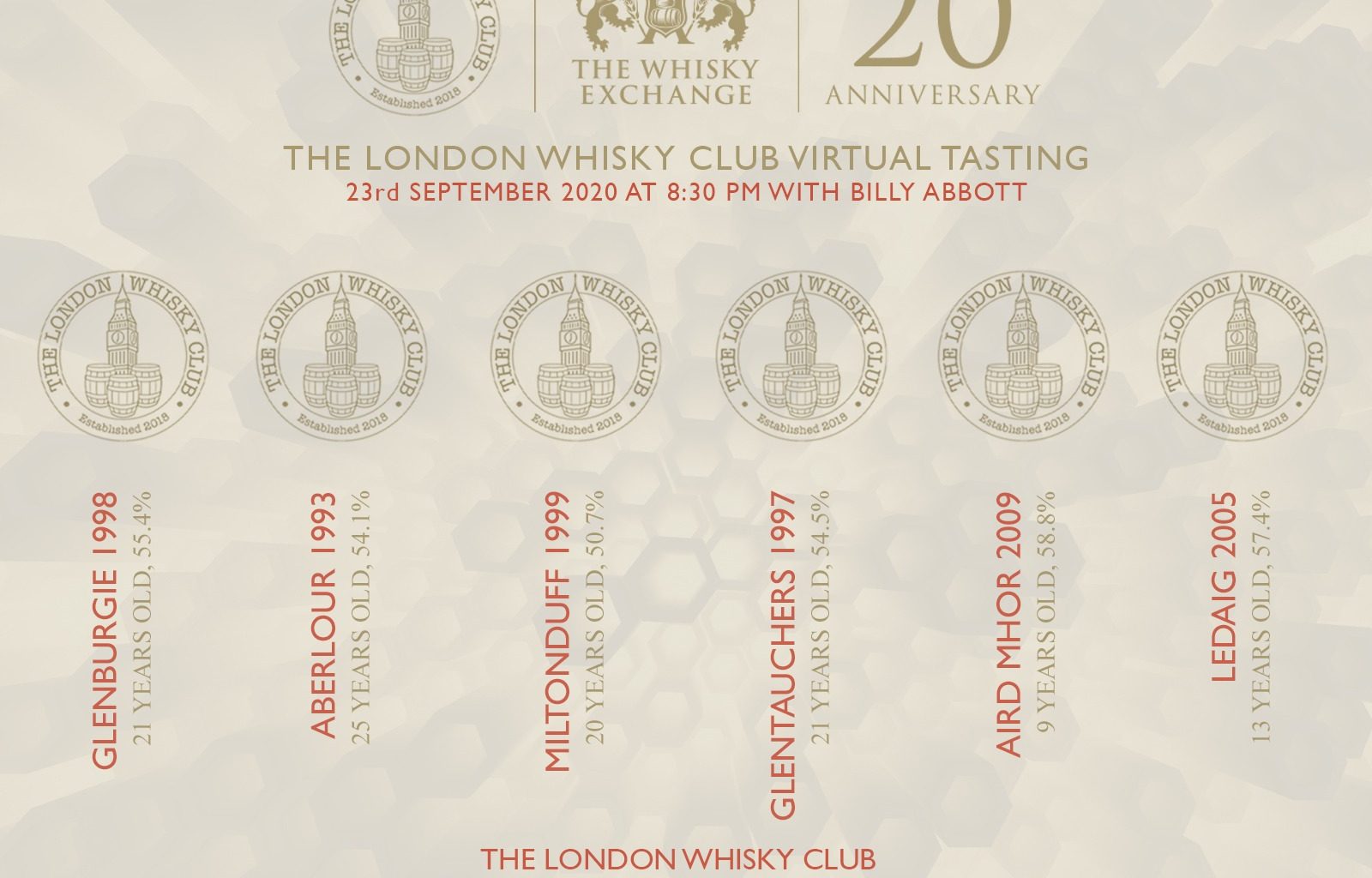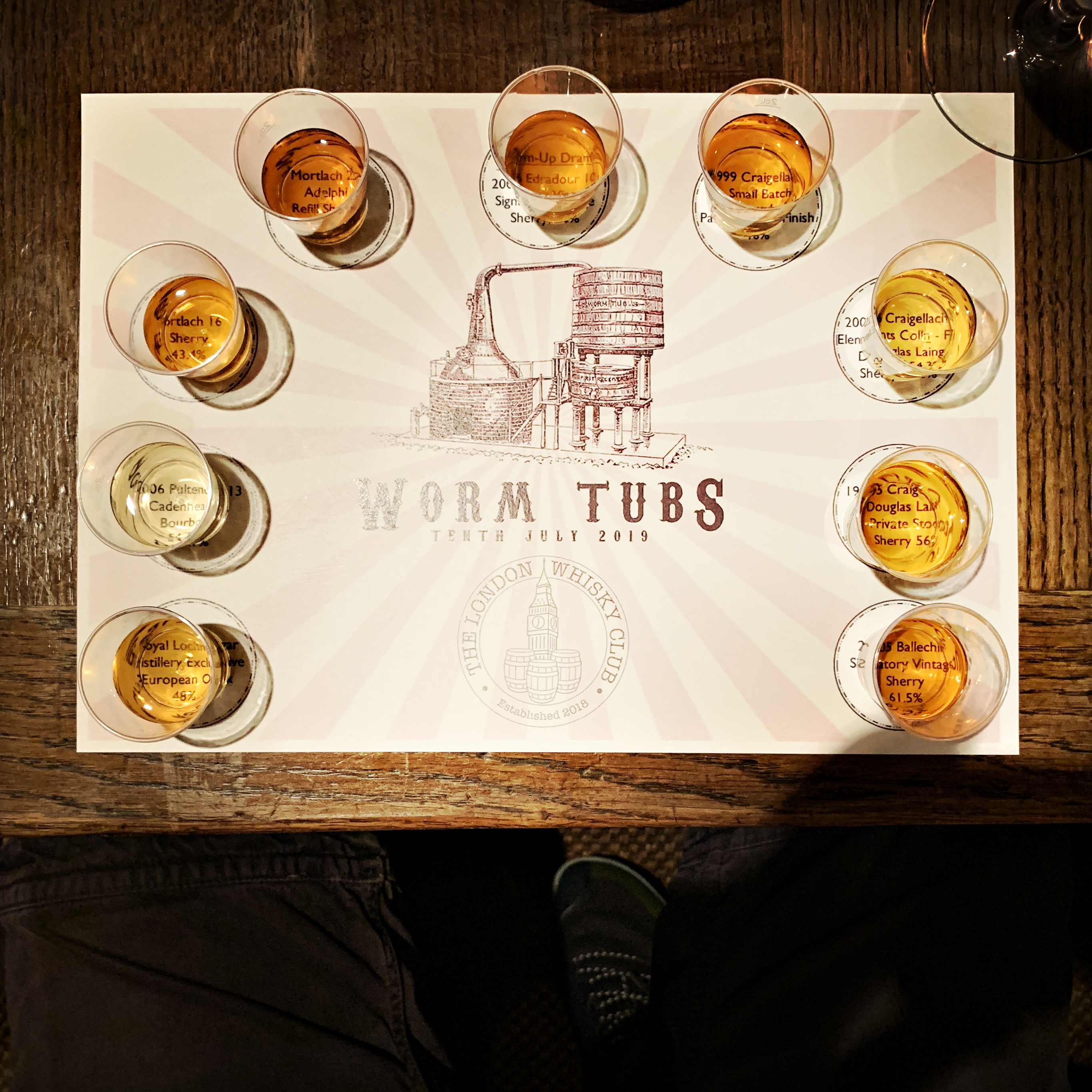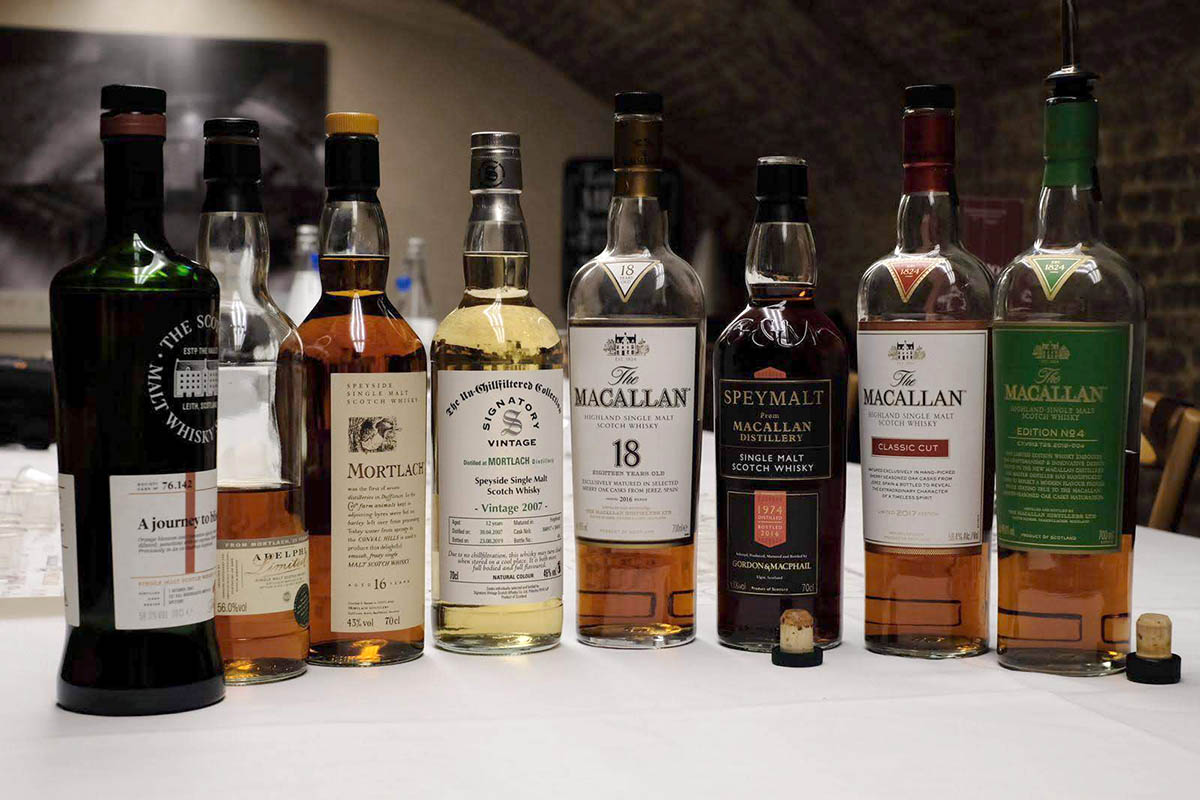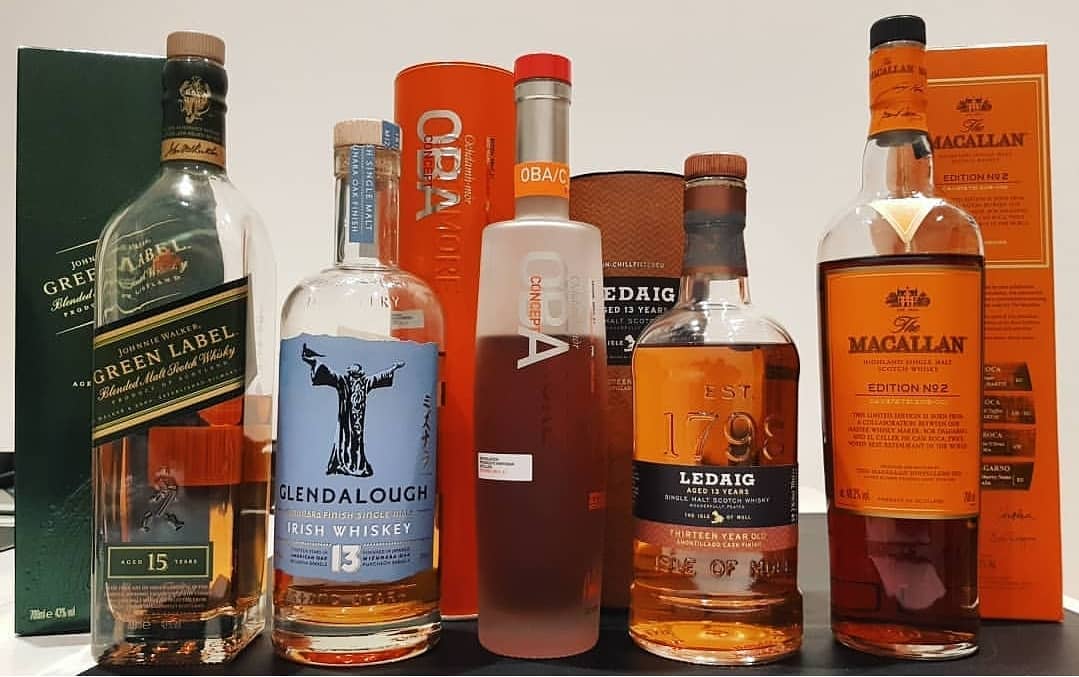Write up by Luke Jones
This week’s tasting from TLWC takes us back to The Whisky Exchange for another offering, and walking us through the drams is the one and only Billy Abbot. This man – and his aliases – need no introduction. You may know him better as Meatrobot or Cowfish and I’m sure if you searched hard enough, you would find many more. Billy seems to have done almost everything at TWE ranging from product descriptions to internal and external training to blogging, so we are fortunate to have him with us tonight.
The range we will be sampling tonight is The Whisky Exchange Single Casks; in TWE’s own words these are “a selection of single-cask whiskies we like enough to put our name on them, bottled from our own stocks. Drams we love from distilleries we admire.”
Before diving into the drams, let’s briefly discuss the background of TWE. It started life in the 70’s as a general corner shop that happened to sell alcohol, but over time it migrated into more of an alcohol specialist. Then in the 90s when Sukhinder (its co-founder) graduated as a chartered surveyor in the middle of the housing crisis, he found himself trying to enter a job market that had just hit rock bottom. He decided to join the family business and shortly after they won the award of off-licence of the year, the grand prize being a trip around the world. While the owners (Sukhinder’s parents) were sailing around the globe and wine tasting in the vineyards of Australia, Sukhinder decided to take on the task of remodelling the shop. Not only did he extend and remodel, but he also took the risky decision to change the business focus to specialise in fine spirits. In 1993 the parents decided to retire leaving brothers Raj and Sukhinder with a tough decision to make; take it on themselves, or look for alternative employment. The brothers took the bold decision to continue the business, but with some drastic changes. They closed the physical shop and took trading online in an effort to keep up with changing spending habits. Initially run out of their bedroom, over the years they grew and expanded, slowly establishing themselves as the largest online whisky store.
TWE has flourished since the turn of the Millennium, surviving the dotcom crisis and continuing to strengthen thereafter. Almost seven years after the closure of the family store, the first TWE shop opened: The Whisky Exchange Shop at Vinopolis. While it eventually shut down in December 2015, fortunately there were already plans in place to open a second London shop and The Whisky Exchange Covent Garden was born in October 2015 – the new flagship. A second finally followed at Great Portland Street in 2018, and in January 2020, TWE opened its third store in London Bridge. All three are normally open seven days a week and for any whisky lover, they’re a sight for sore eyes and must-visit destinations.
The range we’ll be tasting tonight came about from Sukinder wanting to bottle his own whisky again, having spun off the Single Malts of Scotland brand to Elixir Distilleries. This range was launched exactly 51 weeks ago at The Whisky Show 2019.
Our exciting line-up for the night’s tasting:
- Glenburgie 1998, 21y/o, 55.4%
- Aberlour 1993, 25y/o, 54.1%
- Miltonduff 1999, 2y/o, 50.7%
- Glentauchers 1997, 21y/o, 54.5%
- Aird Mhor 2009, 9y/o, 58.5%
- Ledaig 2005, 13y/o, 57.4%
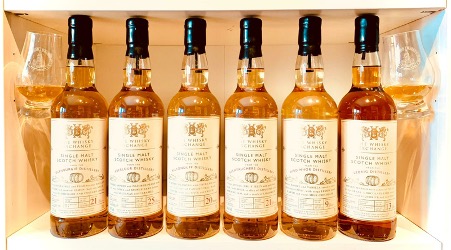
Dram 1 – Glenburgie 1998, 21y/o
Depending on where you read, the distillery is said to have been founded as early as 1810 when it was known as Kilnflat. After running into financial difficulties, the distillery closed in 1870 and reopened in 1878 when it was renamed as Glenburgie. Like so many other distilleries it was further hit with financial woes in the 1920s and closed again between 1927 and 1935. In 1958, the distillery underwent renovation when two Lomond stills were installed, alongside the existing stills; the whisky distilled in said stills was kept separate from the rest of the whisky produced by the distillery and sold under the name Glencraig. Production continued until 1981 when the experiment with Lomond stills was abandoned, and they were replaced with pot stills. In 2000 production again stopped, with the distillery being completely rebuilt in 2003, only retaining the stills from the old distillery; then in 2006 another two were added, bringing the total production capacity to 4.2m litres per year.
Tonight’s dram is cask strength, has no colouring and more importantly is currently getting a lot of love from whisky enthusiasts… luckily for us, Sukhinder recently decided it was the right time to bottle some of his Glenburgie casks. These work well with what he wants to offer from this range; the whiskies have an old-fashioned style and aim to have a lot of the taste coming from the spirit rather than just from the cask. This can be considered as a classic Glenburgie where the flavour lends itself not just to a single malt but also for blending, which is its primary use. For those of us unfamiliar with a classic Glenburgie it’s probably best described as similar to what we expect from Imperial, with its old-fashioned style and the fruity sweet shop (but less grassy) notes.
Dram 2 – Aberlour 1993, 25y/o
The Aberlour Distillery (Speyside) was built by James Fleming in 1879, after having worked at Dailuiane. They began producing whisky from 1880 and after a number of changes in ownership, it was purchased by Pernod Ricard in 1975 when it acquired Campbell Distilleries, and as we all know they joined with Chivas Brothers in 2001. This dram is a classic style for TWE: single cask and ex-bourbon. So, a little bit more about this bottle. We know that it’s not a first fill, but just defined as “refill”. Often bottlers do not know how many previous fills the cask has been subject to, given the large-scale cask brokers do not keep track of this level of information; if you were to call up a broker, they would just send out a lorry full of refill casks. The way in which TWE tracks the best casks is to just take samples and set aside the promising ones to bottle up at a later date then offload the bad ones, likely to be used for blending. Here we have an atypical Aberlour. Having become conditioned to expecting sherry casks, this makes for an interesting change.
Dram 3 – Miltonduff 1999, 20y/o
The Miltonduff distillery (Speyside) was founded by Robert Bain and Andrew Peary in 1824 and was named after an illicit distillery known as Milton; the suffix was added for the Duff family, who owned the land. Following Hiram Walker Gooderham and Worts’ acquisition of George Ballantine and Son in 1935, they quickly identified the need for a stable supply of Scotch malt whisky. Subsequently, the Miltonduff distillery was acquired a year later and from then on, their whisky has become an important component of Ballantine’s blends. Since 2005 the distillery has been under the ownership of Chivas Brothers. So, another blending whisky that doesn’t get much attention as a single malt.
With this whisky TWE are trying to create a range from older to more affordable whiskies, and underrated blending whisky fits the latter bracket well. This is another fruity whisky at heart and Billy explains there are a number of steps along the production process where these notes come from. Firstly, they are in the esters that are a product of fermenting the yeast; depending on how you perform the fermentation you may get more esters in the still. Usually the esters are derived from reaction of the fatty acid and alcohol, which will produce fruity notes in the still. In the cask, through the interaction of the spirit with the wood, more fruitiness is added. Thus, a fruity spirit in a fruity cask producing fruity whisky. The vanilla and chocolate notes that are also present can only be coming from the oak of the cask.
Dram 4 – Glentauchers 1997, 21y/o
Glentauchers distillery (Speyside) was founded in 1897 and started producing whisky a year later. It was mothballed in 1985, and subsequently sold to Allied Distillers in 1989; in 1992 the spirit started to flow once more. Whisky from this distillery is rarely bottled as a single malt, instead usually used in blends (namely Ballantines, Teachers and Chivas Regal). The distillery has three spirit stills and three wash stills, providing a total production capacity of 4.5m litres. The typical style, which is also true of tonight’s dram, is fruity and fresh with some oak, all coming from the ex-bourbon refill casks. Surprisingly this one has some heat and even a little spice. From time to time a few good parcels come up and there is a possibility to get good releases similar to this one… so when you find one good bottle, chances are there will be a similar bottle from a sister cask.
Dram 5 – Aird Mhor 2009, 9y/o
Ardmore distillery (Highland) is owned and operated by Beam Suntory, an American subsidiary of Suntory Holdings of Osaka, Japan. The distillery was built in 1898 by Adam Teacher, the son of William Teacher to secure fillings for their blend, Teacher’s Highland Cream. Ardmore’s single malt range has changed names a number of times over the years; originally it was called Traditional Cask, and bottled at 46% ABV. This in turn was superseded by Ardmore Legacy in 2014, with the ABV reduced to 40% and chill filtration applied. Maybe due to the customer reaction Ardmore Traditional Cask was re-launched in early 2015 as Ardmore Tradition, this time at 46% ABV and back to non-chill filtered.
Tonight’s dram has been matured in an ex-Laphroaig cask. The aim is to combine different layers of flavour more than just smoke, but you do get the medicinal Laphroaig smoke coming through here as well as the Ardmore smoky notes. The more eagled-eyed of you may have noticed that bottle is actually called Aird Mhor, and here its being referred to as Ardmore. While the exact reason for this being bottled as Aird Mhor is unknown it’s likely that it was not permitted to use the name Ardmore when bottled, or at least someone thought this was the case. Also, you may have noticed that the label says this is a Speyside whisky when of course, this is a Highland. In fact, Ardmore is on the border of both Highland and Speyside so when someone shouted across the TWE office floor “Hey Billy, Ardmore is in Speyside right?”, without over thinking it he just shouted back “Yep”. Little did Billy know at the time but his answer was to be used on the official bottle labelling; for a number of years to follow that same label template was being used and it has only very recently been updated.
Dram 6 – Ledaig 2005, 13y/o
The new Tobermory distillery, formerly known as Ledaig, was founded in 1798 and has not only changed hands several times but also undergone a number of periods of closure. The only distillery on Mull, its main product, Tobermory single malt, is used in the blends Scottish Leader and Black Bottle. The distillery also produces a smaller amount of peated whisky, which remains known under the former name, Ledaig. More recently in 2012, during the driest summer for thirty years, the distillery was forced to halt production temporarily to preserve the quality and consistency of its whisky. Early the following year, following several further months of unusually dry weather, there was another temporary halt to production; on each occasion, the water level in the small, private loch used to supply water to the distillery had dipped to such low levels that a prolonged period of heavy rainfall was required to replenish the water levels to a satisfactory level.
Ledaig itself has a historical reputation for being not very good; notes associated with the whisky have often comprised things like plimsolls and burning rubber. Then, about 10 years ago, a heavily-sherried released from BBR was the start of its revival and it’s fair to say that it’s now go-to whisky for many. The smokiness of the whisky comes from its use of Islay malt and peat. In fact, it comes from Port Ellen, which is why we get the similar smoke profile to that of Caol Ila and Ardbeg.
DRAM OF THE NIGHT
The unanimous winner for tonight was the Aird Mhor and to be honest, it was my clear favourite also. The runner up was quite close but the Ledaig took second spot.
TASTING NOTES
Glenburgie 1998, 21y/o, 55.4%
Nose: Pears and pineapple, quickly turning sweeter like boiled pineapple sweets and cola cubes. Hints of cream, apple puff pastry or apple tart with the sugary crust. There is also a touch of sourness.
Taste: More of the boiled sweets and some barely sugar. Some oak and a little bit of spice. The sour notes are more prominent with a waxy, polish finish.
Aberlour 1993, 25y/o, 54.1%
Nose: Pears and apples, sugar and honey. Strangely there is some carbon paper, nail polish remover and some spice.
Taste: Sultana, prunes more pears and apples with a sugary pastry crust that’s been lightly dusted with spice and cinnamon. A few drops of water turned this into a fruit bomb before leaving a waxy oak covering in the mouth.
Miltonduff 1999, 20y/o, 50.7%
Nose: Vanilla, creamy seaside toffee or even fudge. Sherbet lemons, candy necklaces and butterscotch topped with pencil shavings and furniture polish.
Taste: Toffee apple at the funfair. Darker flavours like coffee and chocolate with a nutty finish similar to a dark roast espresso with a touch of oak.
Glentauchers 1997, 21y/o, 54.5%
Nose: Wax, polished oak and apples to start. Lemon, peaches and more apples to follow. Shortboard or buttered biscuit or as someone on the night suggested, cold buttered toast.
Taste: This has a buttery velvet feel with a buttery mash notes. Apples come through strong building up to apple pie with a sugary cinnamon spiced crust.
Aird Mhor 2009, 9y/o, 58.5%
Nose: Aromas of bonfire and cooked apples. Lots of wood smoke on the beach with a waft the sea breeze.
Taste: Lots of peat smoke up front. Apples and dark chocolate with leaves and damp wood, like walking through a forest on a damp autumn day. The minerality or salty notes are here too but is balanced with sweet fruit.
Ledaig 2005, 13y/o, 57.4%
Nose: Medicinal peat, damp grass, followed by mango, lemon and sherbet. Hints of mint with plenty of wood smoke and spent fireworks, like Guy Fawkes night in a glass.
Taste: Rich and smoky, chocolate lemon sweets and even more sweets from an old-fashioned sweetshop like cherry lips, palma violets and sherbet. Finishing with smoky mango and TCP or medicinal notes.The next club virtual tasting is one that many members have been waiting for quite some time…yes, it’s the Sherry Armageddon. See you all on Wednesday 14th October.

